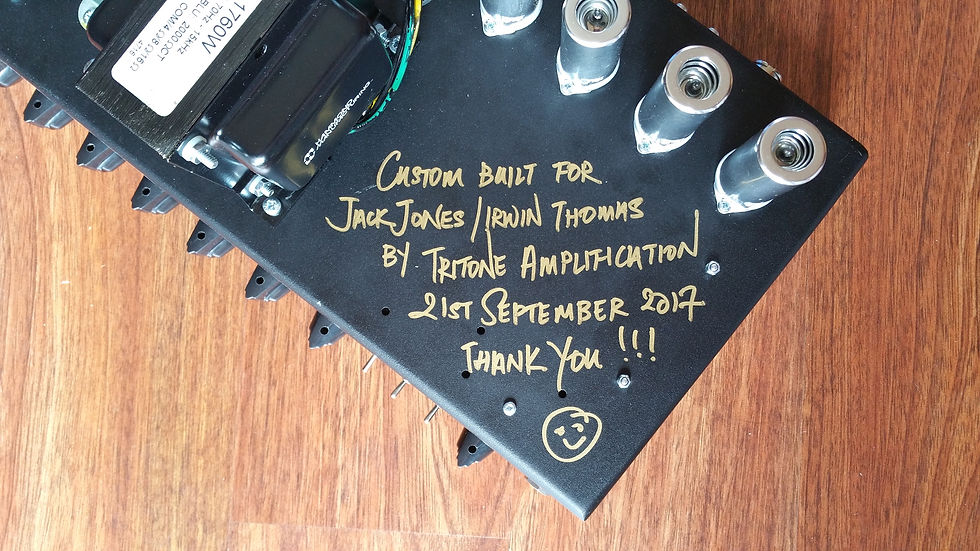T r i t o n e A m p l i f i c a t i o n
Guitar/Bass Amps, Tube/Solid State, Studio Outboard Gear,
Mixing Desks, Hifi Audiophile, Synthesizers, Tape Echoes, etc.
We aren't afraid of working on them. Always keen to see what you have.
Stay updated and current here:
FACEBOOK - www.facebook.com/tritoneamplification
INSTAGRAM - www.instagram.com/tritoneamplification
YOUTUBE - https://www.youtube.com/watch?v=0_vtIF1mRMc&list=UUBvGQpw7l7rP00e5f3g0iRQ
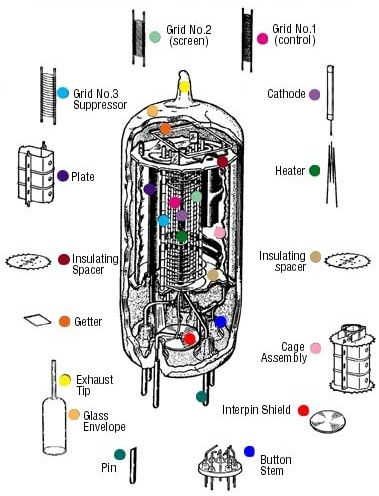
Tubes. How do they work?
Tubes are wonderful devices if they are working right. The heart of any tube gear is the amplifying vacuum tube.
Classical physics tell us that electrons gain enough energy to be liberated from the surface of a metallic element when there is enough heat. Just like a common light bulb, the metallic element has to be enclosed in a vacuum space to limit any combustion due to the presence of oxygen and massive heat energy created by another metallic element called the Heater (or Filament).
Electrons are known to be negatively charged particles and the metallic surface in which they are liberated is called the Cathode because it is a negatively charged element. Within the glass envelope there is another metallic surface which is called the Anode because it is positively charged element. By means of a voltage difference between the two elements, the Anode and Cathode is defined - the element at higher voltage potential is the Anode and vice versa. This difference in voltage potentials, causes the liberated electrons to be attracted and flow thus from the Cathode to Anode.
Yes, contrary to conventional thinking, electrons actually flow from the negative terminal to the positive terminal. Ever looked at the side of a car or bicycle and seen the spokes of the wheels make an image of a spin in contrary to the rotational direction of wheel itself?
So back to the vacuum tube, we have explained the purposes of the various elements in a vacuum tube: the Heater, the Cathode and the Anode. There is a 4th element called the Grid. Without the Grid, the electrons will just be flowing in a constant stream.
Like in a magnet where similar poles repel, an electron being a negative charge particle will be repelled by a negatively charged element. Placing a negatively charged Grid in the path of the electrons, disrupts (and in extreme cases, obstructs) the constant flow of electrons from the Cathode to the Anode. When properly designed, we can use the Grid to control the flow of electrons from the Cathode to the Anode. A more precise name is hence given to the Grid as the Control Grid.
In a more sophisticated arrangement, a negatively charged Grid changes its charge strength in accordance to an input signal and thus controlling the flow of electrons in the glass envelope, which in turn affects a large fluctuating voltage at a load connected to the Anode. Viola! We have effectively amplified the input signal!
PS. We can see this in an analogy of a water tap valve - the Control Grid mimics the valve closing and opening. The inflow being the Cathode and the outflow being the Anode.

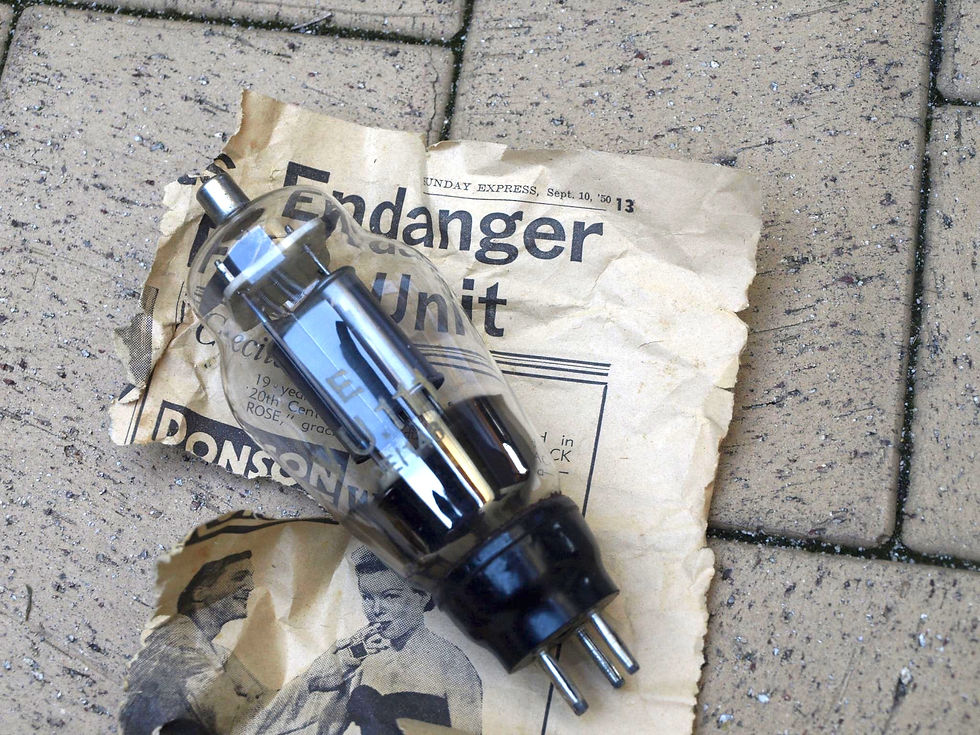
State of the tube industry.
Back when there was only tube technology, quality was consistent, especially during the height of the last two world wars and throughout the 1970s and 1980s of the Cold War era. The rise of the solid state transistor offered many advantages - cooler operation, lower power dissipation, smaller footprint, etc. and therefore electronics designers were in favor of adopting it. This alternative competing technology led to the slow decline of the vacuum tube.
The economy of tube manufacture became untenable and costly to run. Manufacturers had to cut corners and make compromises to make up for poor yield. Quality of tubes could not match the earlier days. Even some materials used in the manufacture of vacuum tubes were found to be toxic or radioactive.
Tubes made during the early years are acknowledged to be generally of better quality than current production. There are still many caches of unused old stock (a.k.a. NOS for New Old Stock) left over from these golden years. A lot of them were made far better than any of the current produced lot. Some NOS tubes are also coveted for the way they color the tone of the amp.
Currently a handful of tubes are manufactured in countries like Russia, China, Yugoslavia, Czechoslovakia and some Eastern bloc countries, where just a decade or two ago, they were still using vacuum tubes and slow to play catch up. Health regulations are usually lax there and manufacturing equipment can still be found. The disintegration of the Soviet Union also meant that there is a stream of Russian tube equivalents easily available and which were meant to be for military consumption. In fact, enterprising businessmen from the West have been rebadging these ex-Soviet stock as the beloved TungSol, Mullard, Genelec etc reissues. (NB. These tubes are generally well made, but the intention to fool consumers through deceptive marketing is still dishonest).
The manufacturing of tubes is very old school crude clockwork, not like today's clean room robot automated machinery which can manufacture to tight micrometer tolerances. You have to rewind 60 years back in time - think hand hammered, hand made human precision mixed in with a little bit of the industrial "sophistication" of that era. Despite the prevailing technological advances, machines and methods in making vacuum tubes have largely stayed the same. The advances have not been applied here as I assume it does not seem fit to outfit a factory with precision equipment to make business sense for a much smaller market of tube consumers.
The recipe for good stable tube that matches textbook specification and curves, which must be replicated across every shipment batch is an engineering feat to achieve. Even in today's solid state industry, that is still quite a formidable task. Production output also need to follow demand and consumption trends, which is unfortunately lower than during the golden age of the vacuum tube. Thus good yield and strict quality control is always at odds with high financial returns.
Skilled inside know-how has been long gone. Certain critical materials in the manufacture of tubes have been banned for health reasons.
Trying to make good tubes in this current generation we live in is lined full of hurdles. There are good current production tubes out there, but the risk of poor quality tubes is usually less with NOS and thus make more sense than a lottery pick from a batch of current production tubes.
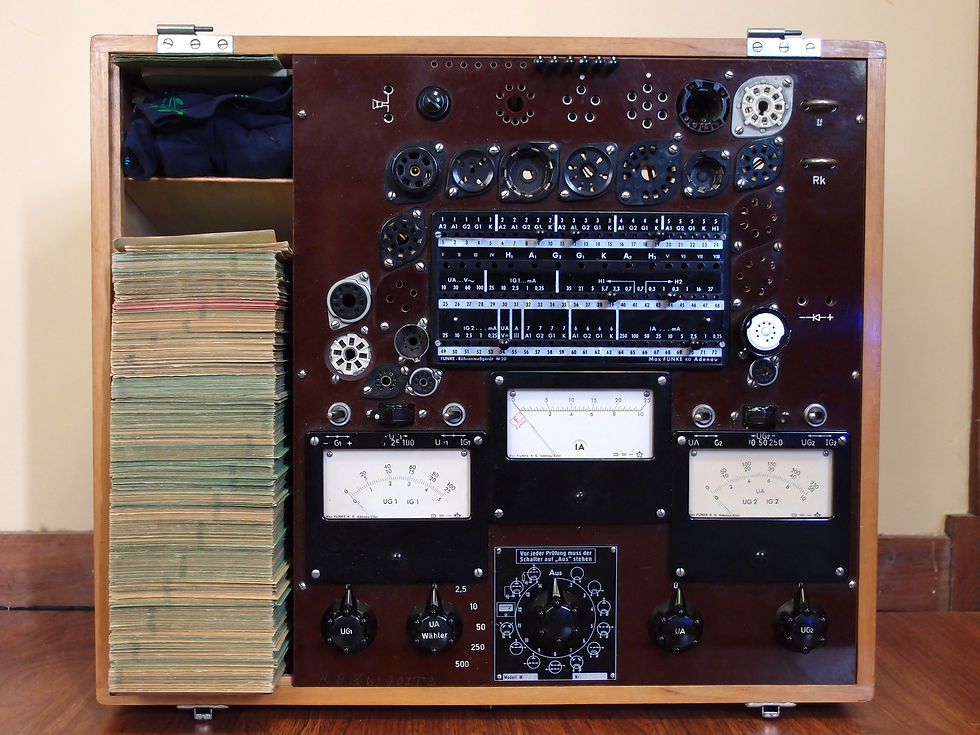
Tube testers and curve tracers
We tend to be more thorough when testing our tubes. You never know when you get lemon. Even reputable manufacturers have lemons once in a while - it is part and parcel of mass manufacturing.
We use both digital and analog testers. Both types have their advantages and disadvantages. Digital testers are great convenient tools, but they don't test at full voltages and currents. In order to remain compact and light and draw less power with smaller transformers and from being overloaded, digital testers pulse the tubes under test and read the tube parameters at very quick split second timings. They are accurate and quick with most tubes. They are usually interfaced to a computer and can trace plot the tube characteristics and let you know how they behave across a range of values. This is called Curve Tracing.
Old school analog testers on the other hand, require human intervention to set the test parameters and measurements are read off the meters. To do a curve trace, you'll have to laboriously set each parameter and manually plot the curves out by hand. Analog testers are rugged and can test at higher currents than a digital tester. They are especially good for testing power tubes that draw heavy currents and voltages and they can supply the high heater currents these tubes require. Because tubes are not pulsed in this case, they are usually given a good run - sometimes a digital tester doesn't push the tube enough for faults to appear or misbehave. I have personally come across tubes that behave in a digital tester but tested faulty on a full analog tester.
I use an old German built Funke W20 tube tester from the 1960s and a Soviet-era Russian Kalibr L3-3. Both are very feature filled and very powerful analog tube testers. Both are military grade equipment and can test tubes for shorts, leakages, etc. They can handle big hefty power tubes easily. The Kalibr L3-3 can even do transconductance measurements.
For curve tracing and straightforward light tests, I have my own home built digital tester. It's also a very accurate tester and also measures transconductance, gain, plate resistance, etc. It communicates to my Mac on Bluetooth! Building my own tester, made me more aware of the different parameters of a tube and how each one affects the tube's behavior. I also learnt quickly what tubes are good and what tubes to avoid.

Tube matching
An added advantage of having a curve tracer is that it helps you to match tubes more accurately.
Traditional methods of tube matching is usually based on a static test. An arbitrary test point is taken and when the measurement matches that of another tube, both tubes are considered matched.
The assumption that the tube's behavior across a wide range of voltage can be determined by a single static value is entirely in error. When you install tubes into the amp and bias it, it may be matched at that point, but while it traverses the range of values that it is required to operate in, it may not seem so.
Look at the curve trace on the left. There are actually two sets of characteristic curves superimposed on one another. The match is so close that the behavior of one tube mimics the other. This matching can only be visually performed and can be laborious. Depending on what requirement you have (e.g. stereo tube fanatic, guitarist with bat-ears, etc), I can do curve trace at minimal extra cost.
Besides power tube matching, there are also some other tubes that need to be matched.
Most guitar amps use push-pull topology and therefore there is a preamp driver tube called the Phase Inverter (a.k.a. PI) that drives the power tubes. These preamp tubes should have matched sections. If you are at least knowledgable about some tubes stuff, the 12AX7, 12AT7, 12AU7, etc series are dual triodes - two triodes in one glass envelope.
If you own a stereo tube hifi amp, tube matching is also essential. You want both channels to be balanced or else your stereo imaging is skewed. So if you have a stereo tube amp that uses 2 tubes per channel, then you need all 4 tubes to be matched, not to mention the PI.

PCB (Printed Circuit Boards) Vs PTP (Point To Point) handwiring talk
My personal view is that there are good PCBs and there are good PTP handwired designs. In the same vein, there are badly designed PCBs and badly executed PTP handwired designs.
It is all in how they are executed. I have seen them and can attest to it.
Take a look at a handwired Matchless amp or a 65 Amp. It has the most unintelligible wiring I've ever seen. There's no marking whatsoever of what value or designation a component is. It gets worse when the circuit gets more complex. Handwiring consistency becomes questionable when the circuit complexity increases. The increased prices for the amps makes you question if you are ultimately paying for the manual labor to handwire them or the amp design itself. But take a look at a Ceriatone wired Matchless (Muchless) clone. At least it is done well and neat. Servicing such an amp would be a breeze. With handwired PTP designs, design complexity, intelligibility and consistency is the limiting factor.
How about a PCB based amp like a THD or Fuchs or any German made hi-gain amp? They are usually well made thick PCBs. Consistency is achieved from one amp to another. This is when you want good mass manufactured amp with complex circuits. Try doing a PTP handwired version of a Hughes & Kettner Triamp - the engineer would flip! Now take a look at PCB based amp like a Marshall JCM900 series amp or a Peavey Classic 30. It's no wonder they give PCB amps a bad name - copper tracks and pads that lift when desoldering a component for service! And thin and narrow tracks that can burn up when high current passes through.
So why do people put out a blanket statement saying PTP handwired is best? Well, I think it's because they are ignorant and they are duplicating hearsay that PTP proponents put out. I believe most have not dealt with the designs directly and are just passing on information they hear.
By the way, have you given any thought why PTP amp designers spout sales talk like: "our amps are all custom handwired", "we use XXXX brand mustard caps", "YYYY transformers", etc" ? It's probably because their amps can't get any complex than the usual variations of some Fender, Marshall or Vox amps and the only way they can make their product stand out is by what sort of components are used in the amp build!
The amps are sold by spouting esoteric brand name components to entice buyers. Check how many boutique Fender 5E3 or Vox AC15 cloners are out there. They never fail to make mention they are using some esoteric transformer paired with some esoteric capacitor, etc using old school handwired methods because that's they only way they know how to build an amp and make them sell! And of course the internet is very good at spreading misinformation.
These amp builders are probably old schooled in the PTP handwired method and are unwilling to pick up a mouse to employ modern day CADCAM methods to design a PCB amp. Most of the amp designs that they do never go beyond the simple one or two channel designs because of the increase in design complexity.
It doesn't take an immense number of training hours to learn to handwire an amp. Leo Fender employed common housewives to wire his amps back in the day. To do a PCB requires much more effort than that. Anyone can do a handwired amp, but not everyone can design a PCB based amp!
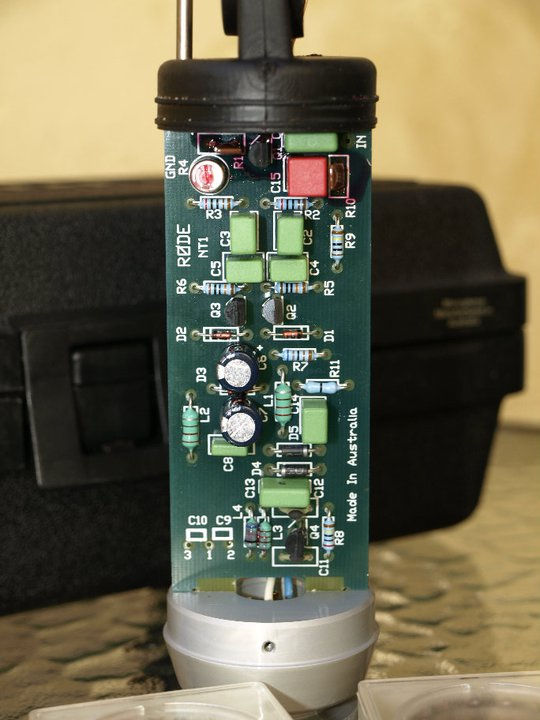
What else do I work on?
Almost anything that has electronics in it and runs off a battery or a wall outlet - synthesizers, mixing consoles, studio monitors, antique radios, microphones, etc.
The only time I reject work is for reasons that the item doesn't cost much to replace and my labor would be costly to justify. That's the reason why I don't work on guitar effects pedals and pickups because they are usually easily fixed by any hobbyist with some knowledge and that they don't cost much to replace.
Of course, if there is something that is rare and irreplaceable and the client is ready to accept the charges, I can have a look still !
